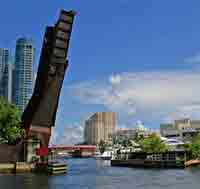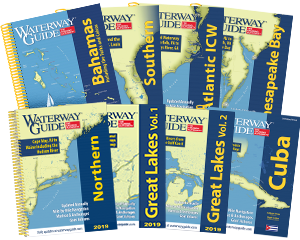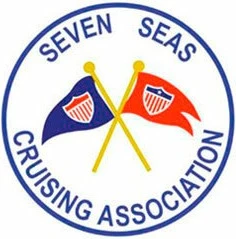 The crowded, narrow New River in Fort Lauderdale is quite a trip, winding through the heart of downtown. It also connects the ICW with many marina and boating facilities upstream, so you best keep a keen watch for the tour boats, mega-yachts (often in tow), and bridges that surprise you around every corner. The bridge tenders are pretty quick on the draw, but when the FEC Railroad Bridge is down, everyone needs to wait in the often-swift current for as long as it takes for a train to pass – unless you can clear 4 feet vertically.
The crowded, narrow New River in Fort Lauderdale is quite a trip, winding through the heart of downtown. It also connects the ICW with many marina and boating facilities upstream, so you best keep a keen watch for the tour boats, mega-yachts (often in tow), and bridges that surprise you around every corner. The bridge tenders are pretty quick on the draw, but when the FEC Railroad Bridge is down, everyone needs to wait in the often-swift current for as long as it takes for a train to pass – unless you can clear 4 feet vertically.
Since April, the bridge has been "testing" new regulations in advance of the late 2016 start of a new passenger rail service – All Aboard Florida – which plans to add a reported 32 train crossings on this bridge, the bridge across the St. Lucie River/Okeechobee Waterway, the bridge across the Loxahatchee River in Jupiter FL, and many road crossings in a number of waterway towns, including Vero Beach.
The proposed regulation requires the bridge to be open at least 60 minutes in every 2 hour period and be tended constantly. But is it actually being tested for the train traffic expected once All Aboard Florida starts running the rails?
The answer is "not really."
Throughout the test period, a bridge tender has been on site constantly, even though the openings are controlled by operators in Jacksonville. Each of the 14-16 daily closures of the bridge last between 10 and 15 minutes, according to the bridge tender – much shorter than the average 19 minutes reported before the test period started. This positive change has been noted by users of the waterway, including the dozens of maritime facilities upstream that rely on the river for their livelihood. However, the bridge has been closing the waterway only for the current freight traffic, rather than the traffic expected when the new rail service starts – about 46 trains per day. The real question is: What will the river traffic look like when the bridge closes two to three times as often?
If the math seems a bit off, here's why: According to the draft study on the impacts of the proposed rail line, the New River bridge would be closed only "30 times a day for an average of 13 minutes" because the train schedules will be set and coordinated – northbound and southbound trains would cross the bridge at the same time during a single bridge closure. If this can truly be acheived, the bridge should be able to easily meet the "open at least 60 minutes in every 2 hour period" requirement. Let's hope they can keep the trains running on time.
The other requirements in the proposed regulations include signage listing the VHF channels and telephone number the bridge tender monitors, and an apparent change in signaling procedure to allow for faster openings and closings. I use the word "apparent" because the FEC Railroad Bridge over the New River doesn't seem to exist in the Code of Federal Regulations for drawbridge operation.
(The other two FEC bridges mentioned above are listed in the CFR with the following regulations:
The draw shall operate as follows:
- The bridge is not constantly tended.
- The draw is normally in the fully open position, displaying flashing green lights to indicate that vessels may pass.
- When a train approaches the bridge, the navigation lights go to flashing red and a horn sounds four blasts, pauses, and then repeats four blasts. After an eight minute delay, the draw lowers and locks, providing the scanning equipment reveals nothing under the draw. The draw remains down for a period of eight minutes or while the approach track circuit is occupied.
- After the train has cleared, the draw opens and the lights return to flashing green.)
Over 3,000 comments were submitted last November when the Coast Guard asked about the navigation needs of mariners at the three railroad drawbridges – most of the comments expressed navigation and/or safety concerns about the possibility of very frequent closures of the waterways. The Coast Guard is asking for comments again, this time with a deadline of December 3, 2015.
Here is the complete Coast Guard Local Notice to Mariners:
The Coast Guard proposes to change the operating schedule that governs the Florida East Coast Railway (FEC) Railroad Bridge across the New River, mile 2.5, at Fort Lauderdale, FL. This proposed rule implements requirements for the operator designed to ensure that adequate notice of bridge closure times are available to the waterway traffic. It also changes the on demand schedule to an operating regulation requiring the bridge to be open at least 60 minutes in every 2 hour period. Modifying the bridge operating schedule will allow the bridge owner to operate the bridge remotely with assistance from the onsite bridge tender.
DATES: Comments and related material must reach the Coast Guard on or before December 3, 2015.
This proposed rule is for the draw of the FEC Railroad Bridge across the New River, mile 2.5, at Fort Lauderdale, FL, to operate as
follows:
(a) The bridge shall be tended constantly.
(b) The bridge tender will utilize a VHF-FM radio to communicate on channels 9 and 16 and may be contacted by telephone at 305-889-5572.
(c) Signs will be posted displaying VHF radio contact information and telephone numbers for the bridge tender and dispatch. A countdown clock giving notice of the time remaining before bridge closure shall be posted at the bridge site and visible for maritime traffic.
(d) A bridge log will be maintained including, at a minimum, bridge opening and closing times.
(e) When the draw is in the fully open position, green lights will be displayed to indicate that vessels may pass.
(f) When a train approaches, the lights flash red and a horn starts four blasts, pauses, and then continues four blasts, then the draw lowers and locks.
(g) After the train has cleared the bridge, the draw opens and the lights turn to green.
(h) The bridge shall not be closed more than 60 minutes combined for any 120 minute time period beginning at 12:01 a.m. each day.
(i) The bridge shall remain open to maritime traffic when trains are not crossing.
You may submit comments identified by docket number USCG-2015-0271 using the Federal eRulemaking Portal at http://www.regulations.gov.











